- Home
- Walter Isaacson
Walter Isaacson Great Innovators e-book boxed set Page 37
Walter Isaacson Great Innovators e-book boxed set Read online
Page 37
At an executive session of the board in June, with Amelio out of the room, Woolard described to current directors how he calculated their odds. “If we stay with Gil as CEO, I think there’s only a 10% chance we will avoid bankruptcy,” he said. “If we fire him and convince Steve to come take over, we have a 60% chance of surviving. If we fire Gil, don’t get Steve back, and have to search for a new CEO, then we have a 40% chance of surviving.” The board gave him authority to ask Jobs to return.
Woolard and his wife flew to London, where they were planning to watch the Wimbledon tennis matches. He saw some of the tennis during the day, but spent his evenings in his suite at the Inn on the Park calling people back in America, where it was daytime. By the end of his stay, his telephone bill was $2,000.
First, he called Jobs. The board was going to fire Amelio, he said, and it wanted Jobs to come back as CEO. Jobs had been aggressive in deriding Amelio and pushing his own ideas about where to take Apple. But suddenly, when offered the cup, he became coy. “I will help,” he replied.
“As CEO?” Woolard asked.
Jobs said no. Woolard pushed hard for him to become at least the acting CEO. Again Jobs demurred. “I will be an advisor,” he said. “Unpaid.” He also agreed to become a board member—that was something he had yearned for—but declined to be the board chairman. “That’s all I can give now,” he said. After rumors began circulating, he emailed a memo to Pixar employees assuring them that he was not abandoning them. “I got a call from Apple’s board of directors three weeks ago asking me to return to Apple as their CEO,” he wrote. “I declined. They then asked me to become chairman, and I again declined. So don’t worry—the crazy rumors are just that. I have no plans to leave Pixar. You’re stuck with me.”
Why did Jobs not seize the reins? Why was he reluctant to grab the job that for two decades he had seemed to desire? When I asked him, he said:
We’d just taken Pixar public, and I was happy being CEO there. I never knew of anyone who served as CEO of two public companies, even temporarily, and I wasn’t even sure it was legal. I didn’t know what I wanted to do. I was enjoying spending more time with my family. I was torn. I knew Apple was a mess, so I wondered: Do I want to give up this nice lifestyle that I have? What are all the Pixar shareholders going to think? I talked to people I respected. I finally called Andy Grove at about eight one Saturday morning—too early. I gave him the pros and the cons, and in the middle he stopped me and said, “Steve, I don’t give a shit about Apple.” I was stunned. It was then I realized that I do give a shit about Apple—I started it and it is a good thing to have in the world. That was when I decided to go back on a temporary basis to help them hire a CEO.
The claim that he was enjoying spending more time with his family was not convincing. He was never destined to win a Father of the Year trophy, even when he had spare time on his hands. He was getting better at paying heed to his children, especially Reed, but his primary focus was on his work. He was frequently aloof from his two younger daughters, estranged again from Lisa, and often prickly as a husband.
So what was the real reason for his hesitancy in taking over at Apple? For all of his willfulness and insatiable desire to control things, Jobs was indecisive and reticent when he felt unsure about something. He craved perfection, and he was not always good at figuring out how to settle for something less. He did not like to wrestle with complexity or make accommodations. This was true in products, design, and furnishings for the house. It was also true when it came to personal commitments. If he knew for sure a course of action was right, he was unstoppable. But if he had doubts, he sometimes withdrew, preferring not to think about things that did not perfectly suit him. As happened when Amelio had asked him what role he wanted to play, Jobs would go silent and ignore situations that made him uncomfortable.
This attitude arose partly out of his tendency to see the world in binary terms. A person was either a hero or a bozo, a product was either amazing or shit. But he could be stymied by things that were more complex, shaded, or nuanced: getting married, buying the right sofa, committing to run a company. In addition, he didn’t want to be set up for failure. “I think Steve wanted to assess whether Apple could be saved,” Fred Anderson said.
Woolard and the board decided to go ahead and fire Amelio, even though Jobs was not yet forthcoming about how active a role he would play as an advisor. Amelio was about to go on a picnic with his wife, children, and grandchildren when the call came from Woolard in London. “We need you to step down,” Woolard said simply. Amelio replied that it was not a good time to discuss this, but Woolard felt he had to persist. “We are going to announce that we’re replacing you.”
Amelio resisted. “Remember, Ed, I told the board it was going to take three years to get this company back on its feet again,” he said. “I’m not even halfway through.”
“The board is at the place where we don’t want to discuss it further,” Woolard replied. Amelio asked who knew about the decision, and Woolard told him the truth: the rest of the board plus Jobs. “Steve was one of the people we talked to about this,” Woolard said. “His view is that you’re a really nice guy, but you don’t know much about the computer industry.”
“Why in the world would you involve Steve in a decision like this?” Amelio replied, getting angry. “Steve is not even a member of the board of directors, so what the hell is he doing in any of this conversation?” But Woolard didn’t back down, and Amelio hung up to carry on with the family picnic before telling his wife.
At times Jobs displayed a strange mixture of prickliness and neediness. He usually didn’t care one iota what people thought of him; he could cut people off and never care to speak to them again. Yet sometimes he also felt a compulsion to explain himself. So that evening Amelio received, to his surprise, a phone call from Jobs. “Gee, Gil, I just wanted you to know, I talked to Ed today about this thing and I really feel bad about it,” he said. “I want you to know that I had absolutely nothing to do with this turn of events, it was a decision the board made, but they had asked me for advice and counsel.” He told Amelio he respected him for having “the highest integrity of anyone I’ve ever met,” and went on to give some unsolicited advice. “Take six months off,” Jobs told him. “When I got thrown out of Apple, I immediately went back to work, and I regretted it.” He offered to be a sounding board if Amelio ever wanted more advice.
Amelio was stunned but managed to mumble a few words of thanks. He turned to his wife and recounted what Jobs said. “In ways, I still like the man, but I don’t believe him,” he told her.
“I was totally taken in by Steve,” she said, “and I really feel like an idiot.”
“Join the crowd,” her husband replied.
Steve Wozniak, who was himself now an informal advisor to the company, was thrilled that Jobs was coming back. (He forgave easily.) “It was just what we needed,” he said, “because whatever you think of Steve, he knows how to get the magic back.” Nor did Jobs’s triumph over Amelio surprise him. As he told Wired shortly after it happened, “Gil Amelio meets Steve Jobs, game over.”
That Monday Apple’s top employees were summoned to the auditorium. Amelio came in looking calm and relaxed. “Well, I’m sad to report that it’s time for me to move on,” he said. Fred Anderson, who had agreed to be interim CEO, spoke next, and he made it clear that he would be taking his cues from Jobs. Then, exactly twelve years since he had lost power in a July 4 weekend struggle, Jobs walked back onstage at Apple.
It immediately became clear that, whether or not he wanted to admit it publicly (or even to himself), Jobs was going to take control and not be a mere advisor. As soon as he came onstage that day—wearing shorts, sneakers, and a black turtleneck—he got to work reinvigorating his beloved institution. “Okay, tell me what’s wrong with this place,” he said. There were some murmurings, but Jobs cut them off. “It’s the products!” he answered. “So what’s wrong with the products?” Again there were a few attempts at an ans
wer, until Jobs broke in to hand down the correct answer. “The products suck!” he shouted. “There’s no sex in them anymore!”
Woolard was able to coax Jobs to agree that his role as an advisor would be a very active one. Jobs approved a statement saying that he had “agreed to step up my involvement with Apple for up to 90 days, helping them until they hire a new CEO.” The clever formulation that Woolard used in his statement was that Jobs was coming back “as an advisor leading the team.”
Jobs took a small office next to the boardroom on the executive floor, conspicuously eschewing Amelio’s big corner office. He got involved in all aspects of the business: product design, where to cut, supplier negotiations, and advertising agency review. He believed that he had to stop the hemorrhaging of top Apple employees, and to do so he wanted to reprice their stock options. Apple stock had dropped so low that the options had become worthless. Jobs wanted to lower the exercise price, so they would be valuable again. At the time, that was legally permissible, but it was not considered good corporate practice. On his first Thursday back at Apple, Jobs called for a telephonic board meeting and outlined the problem. The directors balked. They asked for time to do a legal and financial study of what the change would mean. “It has to be done fast,” Jobs told them. “We’re losing good people.”
Even his supporter Ed Woolard, who headed the compensation committee, objected. “At DuPont we never did such a thing,” he said.
“You brought me here to fix this thing, and people are the key,” Jobs argued. When the board proposed a study that could take two months, Jobs exploded: “Are you nuts?!?” He paused for a long moment of silence, then continued. “Guys, if you don’t want to do this, I’m not coming back on Monday. Because I’ve got thousands of key decisions to make that are far more difficult than this, and if you can’t throw your support behind this kind of decision, I will fail. So if you can’t do this, I’m out of here, and you can blame it on me, you can say, ‘Steve wasn’t up for the job.’”
The next day, after consulting with the board, Woolard called Jobs back. “We’re going to approve this,” he said. “But some of the board members don’t like it. We feel like you’ve put a gun to our head.” The options for the top team (Jobs had none) were reset at $13.25, which was the price of the stock the day Amelio was ousted.
Instead of declaring victory and thanking the board, Jobs continued to seethe at having to answer to a board he didn’t respect. “Stop the train, this isn’t going to work,” he told Woolard. “This company is in shambles, and I don’t have time to wet-nurse the board. So I need all of you to resign. Or else I’m going to resign and not come back on Monday.” The one person who could stay, he said, was Woolard.
Most members of the board were aghast. Jobs was still refusing to commit himself to coming back full-time or being anything more than an advisor, yet he felt he had the power to force them to leave. The hard truth, however, was that he did have that power over them. They could not afford for him to storm off in a fury, nor was the prospect of remaining an Apple board member very enticing by then. “After all they’d been through, most were glad to be let off,” Woolard recalled.
Once again the board acquiesced. It made only one request: Would he permit one other director to stay, in addition to Woolard? It would help the optics. Jobs assented. “They were an awful board, a terrible board,” he later said. “I agreed they could keep Ed Woolard and a guy named Gareth Chang, who turned out to be a zero. He wasn’t terrible, just a zero. Woolard, on the other hand, was one of the best board members I’ve ever seen. He was a prince, one of the most supportive and wise people I’ve ever met.”
Among those being asked to resign was Mike Markkula, who in 1976, as a young venture capitalist, had visited the Jobs garage, fallen in love with the nascent computer on the workbench, guaranteed a $250,000 line of credit, and become the third partner and one-third owner of the new company. Over the subsequent two decades, he was the one constant on the board, ushering in and out a variety of CEOs. He had supported Jobs at times but also clashed with him, most notably when he sided with Sculley in the showdowns of 1985. With Jobs returning, he knew that it was time for him to leave.
Jobs could be cutting and cold, especially toward people who crossed him, but he could also be sentimental about those who had been with him from the early days. Wozniak fell into that favored category, of course, even though they had drifted apart; so did Andy Hertzfeld and a few others from the Macintosh team. In the end, Mike Markkula did as well. “I felt deeply betrayed by him, but he was like a father and I always cared about him,” Jobs later recalled. So when the time came to ask him to resign from the Apple board, Jobs drove to Markkula’s chateau-like mansion in the Woodside hills to do it personally. As usual, he asked to take a walk, and they strolled the grounds to a redwood grove with a picnic table. “He told me he wanted a new board because he wanted to start fresh,” Markkula said. “He was worried that I might take it poorly, and he was relieved when I didn’t.”
They spent the rest of the time talking about where Apple should focus in the future. Jobs’s ambition was to build a company that would endure, and he asked Markkula what the formula for that would be. Markkula replied that lasting companies know how to reinvent themselves. Hewlett-Packard had done that repeatedly; it started as an instrument company, then became a calculator company, then a computer company. “Apple has been sidelined by Microsoft in the PC business,” Markkula said. “You’ve got to reinvent the company to do some other thing, like other consumer products or devices. You’ve got to be like a butterfly and have a metamorphosis.” Jobs didn’t say much, but he agreed.
The old board met in late July to ratify the transition. Woolard, who was as genteel as Jobs was prickly, was mildly taken aback when Jobs appeared dressed in jeans and sneakers, and he worried that Jobs might start berating the veteran board members for screwing up. But Jobs merely offered a pleasant “Hi, everyone.” They got down to the business of voting to accept the resignations, elect Jobs to the board, and empower Woolard and Jobs to find new board members.
Jobs’s first recruit was, not surprisingly, Larry Ellison. He said he would be pleased to join, but he hated attending meetings. Jobs said it would be fine if he came to only half of them. (After a while Ellison was coming to only a third of the meetings. Jobs took a picture of him that had appeared on the cover of Business Week and had it blown up to life size and pasted on a cardboard cutout to put in his chair.)
Jobs also brought in Bill Campbell, who had run marketing at Apple in the early 1980s and been caught in the middle of the Sculley-Jobs clash. Campbell had ended up sticking with Sculley, but he had grown to dislike him so much that Jobs forgave him. Now he was the CEO of Intuit and a walking buddy of Jobs. “We were sitting out in the back of his house,” recalled Campbell, who lived only five blocks from Jobs in Palo Alto, “and he said he was going back to Apple and wanted me on the board. I said, ‘Holy shit, of course I will do that.’” Campbell had been a football coach at Columbia, and his great talent, Jobs said, was to “get A performances out of B players.” At Apple, Jobs told him, he would get to work with A players.
Woolard helped bring in Jerry York, who had been the chief financial officer at Chrysler and then IBM. Others were considered and then rejected by Jobs, including Meg Whitman, who was then the manager of Hasbro’s Playskool division and had been a strategic planner at Disney. (In 1998 she became CEO of eBay, and she later ran unsuccessfully for governor of California.) Over the years Jobs would bring in some strong leaders to serve on the Apple board, including Al Gore, Eric Schmidt of Google, Art Levinson of Genentech, Mickey Drexler of the Gap and J. Crew, and Andrea Jung of Avon. But he always made sure they were loyal, sometimes loyal to a fault. Despite their stature, they seemed at times awed or intimidated by Jobs, and they were eager to keep him happy.
At one point he invited Arthur Levitt, the former SEC chairman, to become a board member. Levitt, who bought his first Macintosh in 1984 an
d was proudly “addicted” to Apple computers, was thrilled. He was excited to visit Cupertino, where he discussed the role with Jobs. But then Jobs read a speech Levitt had given about corporate governance, which argued that boards should play a strong and independent role, and he telephoned to withdraw the invitation. “Arthur, I don’t think you’d be happy on our board, and I think it best if we not invite you,” Levitt said Jobs told him. “Frankly, I think some of the issues you raised, while appropriate for some companies, really don’t apply to Apple’s culture.” Levitt later wrote, “I was floored. . . . It’s plain to me that Apple’s board is not designed to act independently of the CEO.”
Macworld Boston, August 1997
The staff memo announcing the repricing of Apple’s stock options was signed “Steve and the executive team,” and it soon became public that he was running all of the company’s product review meetings. These and other indications that Jobs was now deeply engaged at Apple helped push the stock up from about $13 to $20 during July. It also created a frisson of excitement as the Apple faithful gathered for the August 1997 Macworld in Boston. More than five thousand showed up hours in advance to cram into the Castle convention hall of the Park Plaza hotel for Jobs’s keynote speech. They came to see their returning hero—and to find out whether he was really ready to lead them again.
Huge cheers erupted when a picture of Jobs from 1984 was flashed on the overhead screen. “Steve! Steve! Steve!” the crowd started to chant, even as he was still being introduced. When he finally strode onstage—wearing a black vest, collarless white shirt, jeans, and an impish smile—the screams and flashbulbs rivaled those for any rock star. At first he punctured the excitement by reminding them of where he officially worked. “I’m Steve Jobs, the chairman and CEO of Pixar,” he introduced himself, flashing a slide onscreen with that title. Then he explained his role at Apple. “I, like a lot of other people, are pulling together to help Apple get healthy again.”

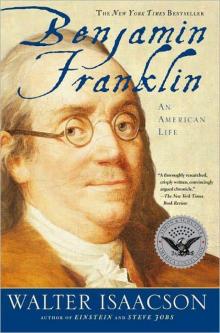 Benjamin Franklin: An American Life
Benjamin Franklin: An American Life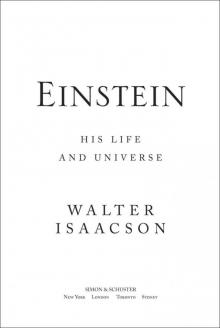 Einstein: His Life and Universe
Einstein: His Life and Universe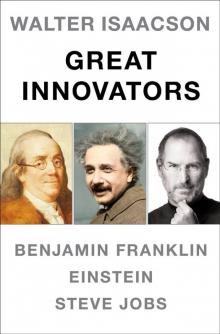 Walter Isaacson Great Innovators e-book boxed set
Walter Isaacson Great Innovators e-book boxed set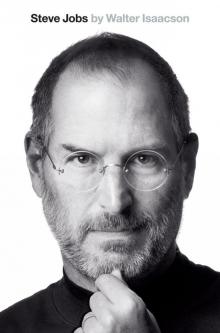 Steve Jobs
Steve Jobs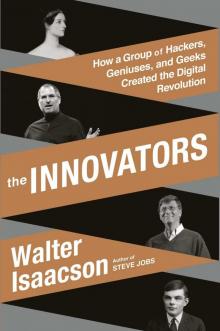 The Innovators
The Innovators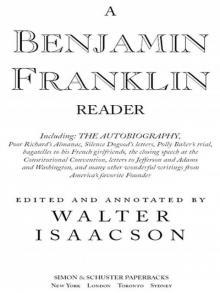 A Benjamin Franklin Reader
A Benjamin Franklin Reader